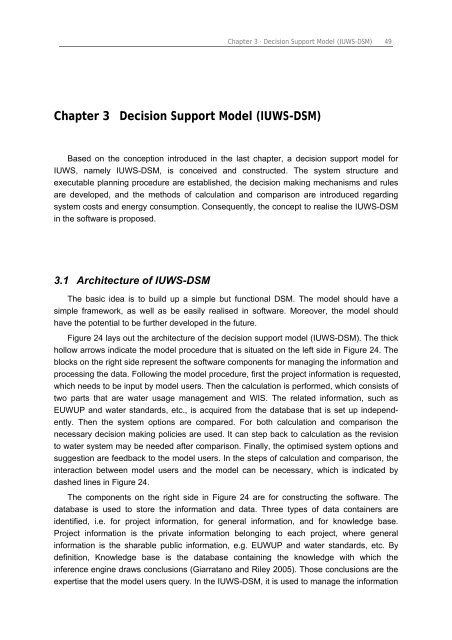Chapter 3 Decision Support Model (IUWS-DSM) - Tubdok
Chapter 3 Decision Support Model (IUWS-DSM) - Tubdok
Chapter 3 Decision Support Model (IUWS-DSM) - Tubdok
You also want an ePaper? Increase the reach of your titles
YUMPU automatically turns print PDFs into web optimized ePapers that Google loves.
<strong>Chapter</strong> 3 · <strong>Decision</strong> <strong>Support</strong> <strong>Model</strong> (<strong>IUWS</strong>-<strong>DSM</strong>) 49<br />
<strong>Chapter</strong> 3 <strong>Decision</strong> <strong>Support</strong> <strong>Model</strong> (<strong>IUWS</strong>-<strong>DSM</strong>)<br />
Based on the conception introduced in the last chapter, a decision support model for<br />
<strong>IUWS</strong>, namely <strong>IUWS</strong>-<strong>DSM</strong>, is conceived and constructed. The system structure and<br />
executable planning procedure are established, the decision making mechanisms and rules<br />
are developed, and the methods of calculation and comparison are introduced regarding<br />
system costs and energy consumption. Consequently, the concept to realise the <strong>IUWS</strong>-<strong>DSM</strong><br />
in the software is proposed.<br />
3.1 Architecture of <strong>IUWS</strong>-<strong>DSM</strong><br />
The basic idea is to build up a simple but functional <strong>DSM</strong>. The model should have a<br />
simple framework, as well as be easily realised in software. Moreover, the model should<br />
have the potential to be further developed in the future.<br />
Figure 24 lays out the architecture of the decision support model (<strong>IUWS</strong>-<strong>DSM</strong>). The thick<br />
hollow arrows indicate the model procedure that is situated on the left side in Figure 24. The<br />
blocks on the right side represent the software components for managing the information and<br />
processing the data. Following the model procedure, first the project information is requested,<br />
which needs to be input by model users. Then the calculation is performed, which consists of<br />
two parts that are water usage management and WIS. The related information, such as<br />
EUWUP and water standards, etc., is acquired from the database that is set up independently.<br />
Then the system options are compared. For both calculation and comparison the<br />
necessary decision making policies are used. It can step back to calculation as the revision<br />
to water system may be needed after comparison. Finally, the optimised system options and<br />
suggestion are feedback to the model users. In the steps of calculation and comparison, the<br />
interaction between model users and the model can be necessary, which is indicated by<br />
dashed lines in Figure 24.<br />
The components on the right side in Figure 24 are for constructing the software. The<br />
database is used to store the information and data. Three types of data containers are<br />
identified, i.e. for project information, for general information, and for knowledge base.<br />
Project information is the private information belonging to each project, where general<br />
information is the sharable public information, e.g. EUWUP and water standards, etc. By<br />
definition, Knowledge base is the database containing the knowledge with which the<br />
inference engine draws conclusions (Giarratano and Riley 2005). Those conclusions are the<br />
expertise that the model users query. In the <strong>IUWS</strong>-<strong>DSM</strong>, it is used to manage the information

















